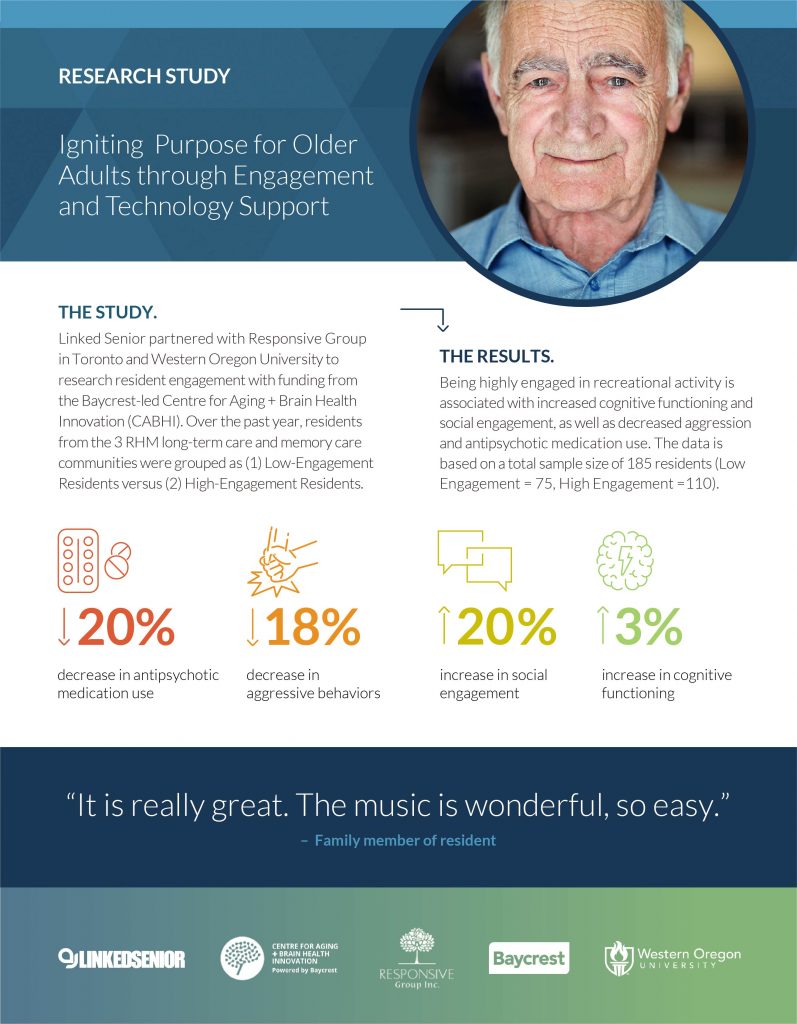As Canadian life expectancy rises, so does the chance that older adults will struggle with isolation—a risk factor for ill health.
It’s a problem innovator Charles de Vilmorin knows well. For years he watched his grandmother, who lived with Alzheimer’s, spend her days alone in her nursing home room, bored and lonely.
He found resident engagement—involving older adults in recreational activities like music and games—an effective antidote. At the same time, he saw frontline recreation staff struggle to deliver personalized care using paper-based tools—an enormous challenge when there can be up to 100 residents per staff member to engage.
Inspired, de Vilmorin co-founded Linked Senior, a platform that digitizes workflow to help staff engage residents in meaningful and personalized activities. The program offers access to cognitive exercises, music, interactive games, and trivia, and is suited for older adults with a wide range of physical and cognitive abilities, including dementia.

Charles de Vilmorin, cofounder of Linked Senior
But even with a tool like Linked Senior, recreation staff face a bigger challenge: convincing institutional leadership to prioritize resident engagement.
“There are still homes in North America where the activity budget is one dollar per resident per month,” says de Vilmorin. “And that’s because there isn’t enough evidence yet of the correlation between resident engagement and clinical and financial benefit.”
Validation in a real-world setting
Linked Senior is overcoming that obstacle by participating in the Baycrest-led Centre for Aging + Brain Health Innovation (CABHI)’s Industry Innovation Partnership Program (I2P2), which gives companies in the aging and brain health space the opportunity to test and validate their innovations in a real-world setting.
Washington, D.C.-based Linked Senior partnered with three Toronto long-term care homes for validation testing, each managed by Responsive Health Management (RHM). 265 residents selected from the sites participated in a clinical study over a one-year period, to determine if residents using Linked Senior had better health outcomes than those who did not.
The preliminary I2P2 study results were extremely positive. Over the first nine months of the study, residents who were highly engaged using the Linked Senior platform showed:
- 20% decrease in antipsychotic medication use
- 18% decrease in aggressive behaviours
- 20% increase in social engagement
- 3% increase in cognitive functioning
The results are poised to advance the field – others will be able to draw on the study’s clinical and financial outcomes to advocate for increased resources in resident engagement. And the I2P2 results are helping Linked Senior significantly strengthen their market value proposition, says de Vilmorin.
“I would invite any entrepreneur or innovator in the aging field to consider the I2P2 program,” he says. “From a company standpoint, it’s one of the best things we’ve done with the highest return on investment.”
Impact on the ground
Christine is a Toronto-based scientist whose mother has been a resident at Cedarvale Terrace, one of the RHM trial sites, for five years. She says using Linked Senior has given her mother the opportunity to maintain her interests even while in long-term care.
“My mother has always liked the sciences, so we use Linked Senior to watch videos about science experiments,” Christine says. “When she’s just sitting there, sometimes it can get depressive – she’ll start thinking about the past. But the Linked Senior activities give her a way to be present in the moment and keep her mind active.”
Clinical staff also see the benefit. RHM senior nurse consultant Marion Godoy, who oversaw the I2P2 trial, says her staff would like to keep using the Linked Senior platform past the trial period.
“Using Linked Senior really encouraged the whole interdisciplinary team to come together and look at behaviour management and meaningful recreation for our residents,” she says. “I really appreciate that the platform uses a holistic approach.”
Linked Senior plans to analyze the I2P2 data even further in the near future. In the meantime, says de Vilmorin, they continue to use Linked Senior to improve residents’ quality of life at RHM and beyond.
“We want to touch as many lives as possible,” he says.

Linked Senior preliminary results


